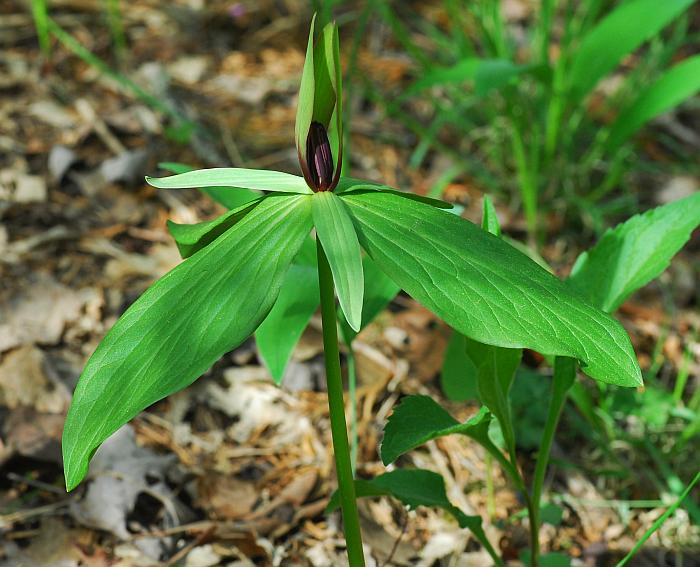Trillium viride L.C. Beck
Green Trillium

Native
CC = 7
CW = 5
MOC = 31
© SRTurner
Trillium viride L.C. BeckGreen Trillium | |
 |
Native CC = 7 CW = 5 MOC = 31 |
© SRTurner |
|
Family - Liliaceae Habit - Rhizomatous perennial forb. Stem - Erect, to 40 cm, glabrous.
Leaves - Whorl of 3 leaves, 8-12 cm long, usually about 2 times longer than wide, elliptic, sessile, often mottled, upper surface with numerous stomates visible with magnification as tiny white speckles. These are barely visible in the leaf photo below, but can be clearly seen in the field using a 10x hand lens.
Flower - Erect, sessile. Sepals 3, spreading to ascending, 3-5 cm long, lanceolate. Petals 3, 4-6 cm long, erect, narrowly oblanceolate, broadest above the middle, with stalklike base 7-15 mm long, light green, sometimes purplish tinged. Stamens 3, 16-24 mm long, less than half as long as petals. Ovary with 6 angles or wings in the upper half.
Fruits - Erect ovoid berries, the tips beaked from the persistent style. Flowering - April - June. Habitat - Mesic forests, ravines, streambanks, usually on calcareous substrate. Origin - Native to the U.S., endemic to MO and IL. Lookalikes - Other species of Trillium, especially T. viridescens and T. sessile. Other info. - This plant is known only from eastern Missouri and a few counties in western Illinois. It appears similar to its lookalikes but can be distinguished by sepals that are spreading (not reflexed) and long, relatively narrow petals with stalklike bases. The petals are usually greenish but can sometimes have a purplish tint, especially at the base. Differentiation of this plant from T. viridescens has been controversial, though the latter species apparently lacks the dense stomates present on the upper leaf surfaces of T. viride. The flowers are said to have a musty oder similar to that of rotting apples. Photographs taken at Washington State Park, Washington County, MO, 5-3-2014 and 4-24-2017, and Danville Conservation Area, Montgomery County, MO, 4-28-2016 (SRTurner). |